Politician Says Blacks Family Units Slavery Better Off
Lydia Maria Child introduced the literary character that we call the tragic mulatto1 in two brusk stories: "The Quadroons" (1842) and "Slavery'southward Pleasant Homes" (1843). She portrayed this light skinned woman as the offspring of a white slaveholder and his black female slave. This mulatto's life was indeed tragic. She was ignorant of both her mother'southward race and her own. She believed herself to be white and free. Her heart was pure, her manners impeccable, her language polished, and her face beautiful. Her father died; her "negro blood" discovered, she was remanded to slavery, deserted by her white lover, and died a victim of slavery and white male person violence. A similar portrayal of the well-nigh-white mulatto appeared in Clotel (1853), a novel written by black abolitionist William Wells Brownish.
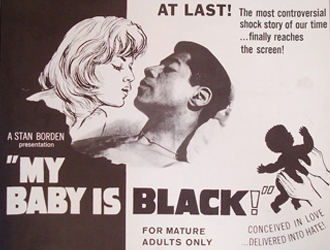
A century subsequently literary and cinematic portrayals of the tragic mulatto emphasized her personal pathologies: self-hatred, depression, alcoholism, sexual perversion, and suicide attempts beingness the most common. If low-cal enough to "pass" as white, she did, simply passing led to deeper self-loathing. She pitied or despised blacks and the "blackness" in herself; she hated or feared whites yet desperately sought their approval. In a race-based society, the tragic mulatto found peace simply in death. She evoked compassion or scorn, not sympathy. Sterling Brown summarized the treatment of the tragic mulatto by white writers:
White writers insist upon the mulatto's unhappiness for other reasons. To them he is the anguished victim of divided inheritance. Mathematically they work it out that his intellectual strivings and self-control come from his white blood, and his emotional urgings, indolence and potential savagery come up from his Negro blood. Their favorite graphic symbol, the octoroon, wretched considering of the "single drop of midnight in her veins," desires a white lover above all else, and must therefore go downwards to a tragic end.(Chocolate-brown, 1969, p. 145)
Vara Caspary'due south novel The White Girl (1929) told the story of Solaria, a beautiful mulatto who passes for white. Her hugger-mugger is revealed by the advent of her dark-brown-skinned brother. Depressed, and assertive that her peel is becoming darker, Solaria drinks poisonous substance. A more than realistic only equally depressing mulatto character is found in Geoffrey Barnes' novel Dark Lustre (1932). Alpine, the light-skinned "heroine," dies in childbirth, merely her white infant lives to continue "a bicycle of pain." Both Solaria and Alpine are repulsed by blacks, especially black suitors.
Most tragic mulattoes were women, although the self-loathing Sergeant Waters in A Soldier's Story (Jewison, 1984) conspicuously fits the tragic mulatto stereotype. The troubled mulatto is portrayed equally a selfish adult female who will give up all, including her black family, in order to live as a white person. These words are illustrative:
Don't come for me. If you come across me in the street, don't speak to me. From this moment on I'1000 White. I am non colored. You take to give me up.
These words were spoken by Peola, a tortured, self-hating black girl in the movie Simulated of Life (Laemmle & Stahl, 1934). Peola, played adeptly past Fredi Washington, had peel that looked white. But she was not socially white. She was a mulatto. Peola was tired of existence treated as a 2d-form citizen; tired, that is, of being treated similar a 1930s black American. She passed for white and begged her mother to understand.
False of Life, based on Fannie Hurst'southward best selling novel, traces the lives of 2 widows, one white and the employer, the other blackness and the retainer. Each woman has one daughter. The white woman, Beatrice Pullman (played by Claudette Colbert), hires the blackness adult female, Delilah, (played past Louise Beavers) as a live-in cook and housekeeper. It is the low, and the two women and their daughters live in poverty -- fifty-fifty a financially struggling white woman can afford a mammy. Their economic salvation comes when Delilah shares a secret pancake recipe with her boss. Beatrice opens a eating house, markets the recipe, and shortly becomes wealthy. She offers Delilah, the eating house's melt, a twenty percent share of the profits. Regarding the recipe, Delilah, a true cinematic mammy, delivers two of the most pathetic lines always from a blackness character: "I gives it to yous, honey. I makes yous a nowadays of it." While Delilah is keeping her mistress'south family unit intact, her relationship with Peola, her daughter, disintegrates.
Peola is the antithesis of the mammy caricature. Delilah knows her place in the Jim Crow hierarchy: the bottom rung. Hers is an all-around resignation, bordering on contentment. Peola hates her life, wants more, wants to live as a white person, to have the opportunities that whites enjoy. Delilah hopes that her daughter will accept her racial heritage. "He [God] made you black, dear. Don't exist telling Him his business concern. Accept it, honey." Peola wants to be loved by a white homo, to marry a white human being. She is beautiful, sensual, a potential married woman to any white man who does not know her secret. Peola wants to live without the stigma of being black -- and in the 1930s that stigma was real and measurable. Ultimately and inevitably, Peola rejects her female parent, runs abroad, and passes for white. Delilah dies of a cleaved heart. A repentant and bawling Peola returns to her female parent's funeral.
Audiences, black and white (and they were separate), hated what Peola did to her mother -- and they hated Peola. She is often portrayed every bit the epitome of selfishness. In many bookish discussions about tragic mulattoes the name Peola is included. From the mid-1930s through the tardily 1970s, Peola was an epithet used past blacks against light-skinned black women who identified with mainstream white society. A Peola looked white and wanted to be white. During the Ceremonious Rights Movement and the Black Power Movement, the name Peola was an insult comparable to Uncle Tom, albeit a light-skinned female version.
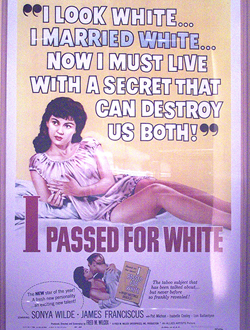
Fredi Washington, the black extra who played Peola, was light enough to pass for white. Rumor has it that in subsequently movies makeup was used to "blacken" her skin and so white audiences would know her race. She had sharply defined features; long, dark, and directly pilus, and green eyes; this limited the roles she was offered. She could not play mammy roles, and though she looked white, no best-selling blackness was allowed to play a white person from the 1930'due south through the 1950's.
Fake of Life was remade in 1959 (Hunter & Sirk). The plot is essentially the aforementioned; yet, Peola is chosen Sara Jane, and she is played past Susan Kohner, a white extra. Delilah is now Annie Johnson. The pancake storyline is gone. Instead, the white mistress is a struggling actress. The crux of the story remains the low-cal-skinned daughter'south attempts to laissez passer for white. She runs away and becomes a chorus girl in a sleazy nightclub. Her nighttime skinned female parent (played by Juanita Moore) follows her. She begs her mother to leave her alone. Sara Jane does not want to ally a "colored chauffeur"; she wants a white boyfriend. She gets a white boyfriend, just, when he discovers her secret, he savagely beats her and leaves her in a gutter. As in the original, Sara Jane's mother dies from a cleaved heart, and the repentant child tearfully returns to the funeral.
Peola and Sara Jane were cinematic tragic mulattoes. They were large screen testaments to the usually held belief that "mixed blood" brought sorrow. If simply they did not have a "drop of Negro blood." Many audience members nodded agreement when Annie Johnson asked rhetorically, "How practise yous explain to your daughter that she was built-in to hurt?"
Were real mulattoes born to hurt? All racial minorities in the United states take been victimized past the ascendant group, although the expressions of that oppression vary. Mulattoes were considered black; therefore, they were slaves forth with their darker kinsmen. All slaves were "born to injure," simply some writers accept argued that mulattoes were privileged, relative to nighttime-skinned blacks. Due east.B. Reuter (1919), a historian, wrote:
In slavery days, they were most frequently the trained servants and had the advantages of daily contact with cultured men and women. Many of them were free and so enjoyed whatever advantages went with that superior status. They were considered by the white people to exist superior in intelligence to the black Negroes, and came to accept great pride in the fact of their white claret....When possible, they formed a sort of mixed-claret caste and held themselves aloof from the black Negroes and the slaves of lower status. (p. 378)

Reuter's merits that mulattoes were held in higher regard and treated ameliorate than "pure blacks" must exist examined closely. American slavery lasted for more two centuries; therefore, it is difficult to generalize about the institution. The interactions between slaveholder and slaves varied across decades--and from plantation to plantation. Notwithstanding, there are clues regarding the condition of mulattoes. In a variety of public statements and laws, the offspring of white-black sexual relations were referred to as "mongrels" or "spurious" (Nash, 1974, p. 287). Also, these interracial children were always legally defined equally pure blacks, which was different from how they were handled in other New Globe countries. A slaveholder claimed that there was "not an onetime plantation in which the grandchildren of the owner [therefore mulattos] are non whipped in the field past his overseer" (Furnas, 1956, p. 142). Further, it seems that mulatto women were sometimes targeted for sexual abuse.
According to the historian J. C. Furnas (1956), in some slave markets, mulattoes and quadroons brought higher prices, because of their apply as sexual objects (p. 149). Some slavers plant nighttime skin vulgar and repulsive. The mulatto approximated the white ideal of female bewitchery. All slave women (and men and children) were vulnerable to being raped, simply the mulatto afforded the slave possessor the opportunity to rape, with impunity, a woman who was physically white (or nigh-white) but legally blackness. A greater likelihood of being raped is certainly not an indication of favored status.
The mulatto adult female was depicted every bit a seductress whose beauty drove white men to rape her. This is an obvious and flawed try to reconcile the prohibitions against miscegenation (interracial sexual relations) with the reality that whites routinely used blacks equally sexual objects. One slaver noted, "In that location is non a likely looking daughter in this State that is not the concubine of a White human being..." (Furnas, 1956, p. 142). Every mulatto was proof that the color line had been crossed. In this regard, mulattoes were symbols of rape and concubinage. Gary B. Nash (1974) summarized the slavery-era relationship between the rape of black women, the handling of mulattoes, and white dominance:
Though skin colour came to assume importance through generations of clan with slavery, white colonists developed few qualms about intimate contact with blackness women. But raising the social status of those who labored at the bottom of society and who were divers as abysmally inferior was a matter of serious business concern. It was resolved by insuring that the mulatto would not occupy a position midway betwixt white and black. Any blackness claret classified a person as black; and to be black was to be a slave.... Past prohibiting racial intermarriage, winking at interracial sexual activity, and defining all mixed offspring every bit blackness, white society found the platonic answer to its labor needs, its extracurricular and inadmissible sexual desires, its compulsion to maintain its culture purebred, and the problem of maintaining, at least in theory, accented social control. (pp. 289-290)
George G. Fredrickson (1971), writer of The Black Epitome in the White Mind, claimed that many white Americans believed that mulattoes were a degenerate race considering they had "White claret" which fabricated them ambitious and ability hungry combined with "Blackness blood" which made them animalistic and savage. The attributing of personality and morality traits to "blood" seems foolish today, simply it was taken seriously in the past. Charles Carroll, author of The Negro a Animate being (1900), described blacks as apelike. Regarding mulattoes, the offspring of "unnatural relationships," they did not have "the right to live," considering, Carroll said, they were the majority of rapists and killers (Fredrickson, 1971, p. 277). His claim was untrue simply widely believed. In 1899 a southern white woman, Fifty. H. Harris, wrote to the editor of the Independent that the "negro brute" who rapes white women was "nearly always a mulatto," with "enough white blood in him to supplant native humility and cowardice with Caucasian audacity" (Fredrickson, 1971, p. 277). Mulatto women were depicted equally emotionally troubled seducers and mulatto men equally power hungry criminals. Nowhere are these depictions more evident than in D. W. Griffith'south film The Birth of a Nation (1915).
The Birth of a Nation is arguably the most racist mainstream movie produced in the United States. This melodrama of the Civil War and Reconstruction justified and glorified the Ku Klux Klan. Indeed, the Klan of the 1920s owes its being to William Joseph Simmons, an itinerant Methodist preacher who watched the motion picture a dozen times, then felt divinely inspired to resurrect the Klan which had been fallow since 1871. D. W. Griffith based the motion picture on Thomas Dixon's anti-black novel The Clansman (1905) (also the original title of the pic). Griffith, following Dixon'south lead, depicted his blackness characters as either "loyal darkies" or brutes and beasts lusting for power and, worse yet, lusting for white women.
The Birth of a Nation tells the story of ii families, the Stonemans of Pennsylvania, and the Camerons of South Carolina. The Stonemans, headed by politician Austin Stoneman, and the Camerons, headed past slaveholder "Lilliputian Colonel" Ben Cameron, have their longtime friendship divided by the Civil State of war. The Civil War exacts a terrible toll on both families: both take sons die in the war. The Camerons, like many slaveholders, suffer "ruin, destruction, rapine, and pillage." The Birth of a Nation depicts Radical Reconstruction equally a time when blacks boss and oppress whites. The film shows blacks pushing whites off sidewalks, snatching the possessions of whites, attempting to rape a white teenager, and killing blacks who are loyal to whites (Leab, 1976, p. 28). Stoneman, a carpetbagger, moves his family unit to the Southward. He falls under the influence of Lydia, his mulatto housekeeper and mistress.
Austin Stoneman is portrayed as a naive pol who betrays his people: whites. Lydia, his lover, is described in a subtitle every bit the "weakness that is to blight a nation." Stoneman sends another mulatto, Silas Lynch, to "aid the carpetbaggers in organizing and wielding the ability of the vote." Lynch, owing to his "white blood," becomes ambitious. He and his agents rile the local blacks. They attack whites and pillage. Lynch becomes lieutenant governor, and his black co-conspirators are voted into statewide political offices. The Birth of a Nation shows black legislators debating a bill to legalize interracial marriage -- their legs propped on tables, eating chicken, and drinking whiskey.
Silas Lynch proposes marriage to Stoneman's daughter, Elsie. He says, "I will build a black empire and you as my queen shall dominion by my side." When she refuses, he binds her and decides on a "forced matrimony." Lynch informs Stoneman that he wants to ally a white woman. Stoneman approves until he discovers that the white woman is his daughter. While this drama unfolds, blacks attack whites. Information technology looks hopeless until the newly formed Ku Klux Klan arrives to reestablish white dominion.
The Nativity of a Nation set the standard for cinematic technical innovation -- the imaginative use of cross-cutting, lighting, editing, and shut-ups. Information technology as well ready the standard for cinematic anti-blackness images. All of the major black caricatures are in the picture show, including, mammies, sambos, toms, picaninnies, coons, beasts, and tragic mulattoes. The depictions of Lydia -- a cold-hearted, hateful seductress -- and Silas Lynch -- a power hungry, sex-obsessed criminal -- were early examples of the pathologies supposedly inherent in the tragic mulatto stereotype.
Mulattoes did non fare better in other books and movies, especially those who passed for white. In Nella Larsen's novel Passing (1929), Clare, a mulatto passing for white, ofttimes is drawn to blacks in Harlem. Her bigoted white husband finds her there. Her issues are solved when she falls to her death from a 6th story window. In the movie Show Boat (Laemmle & Whale, 1936), a beautiful immature entertainer, Julie, discovers that she has "Negro claret." Existing laws held that "one drop of Negro blood makes you a Negro." Her husband (and the movie'due south writers and producer) take this "ane drib rule" literally. The husband cuts her hand with a knife and sucks her blood. This supposedly makes him a Negro. Later on Julie and her newly-mulattoed husband walk hand-in-hand. Still, she is a screen mulatto, and then the movie ends with this former cheerful "white" woman, now a Negro alcoholic.
Lost Boundaries is a book by William L. White (1948), made into a movie in 1949 (de Rochemont & Werker). Information technology tells the story of a troubled mulatto couple, the Johnsons. The hubby is a physician, but he cannot go a task in a southern black hospital because he "looks white," and no southern white infirmary volition hire him. The Johnsons motion to New England and pass for white. They become pillars of their local community -- all the while terrified of being discredited. Years subsequently, when their secret is discovered, the townspeople turn against them. The town's white government minister delivers a sermon on racial tolerance which leads the locals, shamefaced and guilt-ridden, to befriend again the mulatto couple. Lost Boundaries, despite the white minister's sermon, blames the mulatto couple, non a racist culture, for the discrimination and personal conflicts faced by the Johnsons.

In 1958 Natalie Woods starred in Kings Get Forth (Ross & Daves), the story of a young French mulatto who passes for white. She becomes involved with two American soldiers on leave from World State of war Ii. They are both infatuated with her until they discover that her begetter is black. Both men desert her. She attempts suicide unsuccessfully. Given some other chance to live, she turns her family unit's big abode into a hostel for state of war orphans, "those only as deprived of love as herself" (Bogle, 1994, p. 192). At the picture show'southward end, one of the soldiers is dead; the other, missing an arm, returns to the mulatto adult female. They are comparable, both damaged, and information technology is implied that they will marry.
The mulatto women portrayed in Show Boat, Lost Boundaries, and Kings Become Forth were portrayed by white actresses. It was a common practice. Producers felt that white audiences would feel sympathy for a tortured white adult female, even if she was portraying a mulatto character. The audition knew she was really white. In Pinky (Zanuck & Kazan, 1949), Jeanne Crain, a well-known extra, played the function of the troubled mulatto. Her night-skinned grandmother was played by Ethel Waters. When audiences saw Ethel Waters doing menial labor, information technology was consistent with their understanding of a mammy's life, just when Jeanne Crain was shown washing other people's wearing apparel audiences cried.
Even black filmmakers similar Oscar Micheaux made movies with tragic mulattoes. Within Our Gates (Micheaux, 1920) tells the story of a mulatto adult female who is hit by a machine, menaced by a con human being, nearly raped by a white man, and witnesses the lynching of her entire family. God's Stride Children (Micheaux, 1938) tells the story of Naomi, a mulatto who leaves her blackness married man and child and passes for white. Later on, consumed by guilt, she commits suicide. Mulatto actresses played these roles.
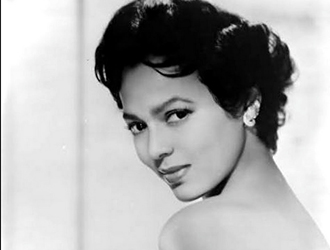 Fredi Washington, the star of Imitation of Life, was one of the first cinematic tragic mulattoes. She was followed by women similar Dorothy Dandridge and Nina Mae McKinney. Dandridge deserves special attention because she non simply portrayed doomed, unfulfilled women, merely she was the embodiment of the tragic mulatto in real life. Her office every bit the lead character in Carmen Jones (Preminger, 1954) helped make her a star. She was the first black featured on the cover of Life magazine. In Isle in the Dominicus (Zanuck & Rossen, 1957) she was the get-go black woman to be held -- lovingly -- in the arms of a white man in an American pic. She was a beautiful and talented actress, just Hollywood was non ready for a black leading lady; the only roles offered to her were variants of the tragic mulatto theme. Her personal life was filled with failed relationships. Disillusioned past roles that limited her to exotic, self-destructive mulatto types, she went to Europe, where she fared worse. She died in 1965, at the age of 40-two, from an overdose of anti-depressants.
Fredi Washington, the star of Imitation of Life, was one of the first cinematic tragic mulattoes. She was followed by women similar Dorothy Dandridge and Nina Mae McKinney. Dandridge deserves special attention because she non simply portrayed doomed, unfulfilled women, merely she was the embodiment of the tragic mulatto in real life. Her office every bit the lead character in Carmen Jones (Preminger, 1954) helped make her a star. She was the first black featured on the cover of Life magazine. In Isle in the Dominicus (Zanuck & Rossen, 1957) she was the get-go black woman to be held -- lovingly -- in the arms of a white man in an American pic. She was a beautiful and talented actress, just Hollywood was non ready for a black leading lady; the only roles offered to her were variants of the tragic mulatto theme. Her personal life was filled with failed relationships. Disillusioned past roles that limited her to exotic, self-destructive mulatto types, she went to Europe, where she fared worse. She died in 1965, at the age of 40-two, from an overdose of anti-depressants.
Today's successful mulatto actresses -- for example, Halle Berry, Lisa Bonet and Jasmine Guy -- owe a debt to the pioneering efforts of Dandridge. These women have bang-up wealth and fame. They are bi-racial, just their statuses and circumstances are not tragic. They are not marginalized; they are mainstream celebrities. Nighttime-skinned actress -- Whoopi Goldberg, Angela Bassett, Alfre Woodard, and Joie Lee -- have enjoyed comparable success. They, too, benefit from Dandridge's path clearing.
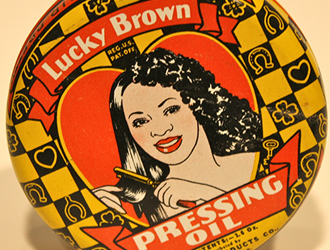
The tragic mulatto was more myth than reality; Dandridge was an exception. The mulatto was fabricated tragic in the minds of whites who reasoned that the greatest tragedy was to exist near-white: so close, yet a racial gulf away. The near-white was to be pitied -- and shunned. There were undoubtedly light skinned blacks, male person and female, who felt marginalized in this race conscious civilization. This was truthful for many people of colour, including dark skinned blacks. Cocky-hatred and intraracial hatred are not limited to light skinned blacks. There is evidence that all racial minorities in the United States have battled feelings of inferiority and in-group animosity; those are, unfortunately, the costs of being a minority.
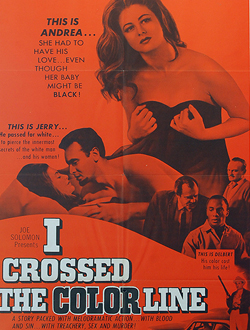
The tragic mulatto stereotype claims that mulattoes occupy the margins of 2 worlds, plumbing equipment into neither, accepted by neither. This is not true of real life mulattoes. Historically, mulattoes were not only accepted into the black community, but were often its leaders and spokespersons, both nationally and at neighborhood levels. Frederick Douglass, Westward.Eastward.B. DuBois, Booker T. Washington, Elizabeth Ross Hayes,2 Mary Church Terrell,3 Thurgood Marshall, Malcolm X, and Louis Farrakhan were all mulattoes. Walter White, the one-time head of the NAACP, and Adam Clayton Powell, an outspoken Congressman, were both light enough to laissez passer for white. Other notable mulattoes include Langston Hughes, Billie Vacation, and Jean Toomer, author of Cane (1923), and the grandson of mulatto Reconstruction politician P.B.S. Pinchback.
There was tragedy in the lives of light skinned black women -- in that location was also tragedy in the lives of most dark skinned black women -- and men and children. The tragedy was non that they were black, or had a drop of "Negro blood," although whites saw that as a tragedy. Rather, the real tragedy was the way race was used to limit the chances of people of color. The 21st century finds an America increasingly more tolerant of interracial unions and the resulting offspring.
© Dr. David Pilgrim, Professor of Sociology
Ferris State Academy
November., 2000
Edited 2012
1 A mulatto is divers as: the first general offspring of a black and white parent; or, an individual with both white and black ancestors. Generally, mulattoes are lite-skinned, though dark plenty to be excluded from the white race.
2 Elizabeth Ross Hayes was a social worker, sociologist, and a pioneer in the YWCA movement.
three Mary Church Terrell was a feminist, civil rights activist, and the first president of the National Association of Colored Women.
References
Barnes, K. (1932). Nighttime lustre. New York, NY: A. H. King.
Bogle. D. (1994). Toms, coons, mulattoes, mammies, & bucks: An interpretive history of Blacks in American films. New York, NY: Continuum.
Brownish, S. (1969). Negro poetry and drama and the Negro in American fiction. New York, NY: Atheneum.
Chocolate-brown, West. West. (1853). Clotel, or, The President's daughter: a narrative of slave life in the United States. London: Partridge & Oakley.
Carroll, C. (1900). "The Negro a creature"; or, "In the image of God". St. Louis, MO: American Volume and Bible House.
Caspary, V. (1929). The white daughter. New York, NY: J. H. Sears & Co.
De Rochemont, 50. (Producer), & Werker, A. L. (Manager). (1949). Lost boundaries [Motion picture]. United states of america: Louis De Rochemont Assembly.
Dixon, T. (1905). The clansman: an historical romance of the Ku Klux Klan. New York, NY: Grosset & Dunlap.
Fredrickson, G. Yard. (1971). The Black Paradigm in the White Mind: The Debate on Afro-American Graphic symbol and Destiny 1817-1914. New York, NY: Harper & Row.
Furnas, J. C. (1956). Goodbye to Uncle Tom. New York, NY: Apollo, 1956.
Griffith, D.W. (Producer/Director) (1915). The nascence of a nation [Picture show]. The states: David W. Griffith Corp.
Hunter, R. (Producer), & Sirk, D. (Director). (1959). Imitation of life [Motility picture]. Us: Universal International Pictures.
Hurst. F. (1933). False of life, a novel. New York, NY: Harper & Bros.
Jewison, Northward. (Producer/Manager). (1984). A soldier's story [Move picture]. The states: Columbia Pictures Corporation.
Laemmle, C. Jr. (Producer), & Stahl, J. M. (Director). (1934). Fake of life [Motion moving-picture show]. Usa: Universal Pictures.
Laemmle, C. Jr. (Producer), & Whale, J. (Managing director). (1936). Show boat [Movie]. United states: Universal Pictures.
Larsen, N. (1929). Passing. New York, NY: Alfred A. Knopf.
Leab, D. (1976). From Sambo to Superspade: The black feel in motion pictures. Boston, MA: Houghton Mifflin.
Micheaux, O. (Producer/Manager). (1938). God'southward stride children [Motility motion-picture show]. United states of america: Micheaux Film.
Micheaux, O. (Producer/Director). (1920). Within our gates [Move motion picture]. United states: Micheaux Book & Film Visitor.
Nash, G. B. (1974). Reddish, white, and black: The peoples of early on America. Englewood Cliffs, NJ: Prentice-Hall.
Preminger, O. (Producer/Manager). (1954). Carmen Jones [Motion motion-picture show]. United States: Carlyle Productions.
Reuter, Eastward. B. (1918). The mulatto in the U.s.. Boston, MA: Annoy.
Ross, F. (Producer), & Daves, D. (Director). (1958). Kings go forth [Motion picture]. United States: Frank Ross-Eton Productions.
Toomer, J. (1923). Pikestaff. New York, NY: Boni and Liveright.
White, Due west. 50. (1948). Lost boundaries. New York, NY: Harcourt, Brace.
Zanuck, D. F. (Producer), & Kazan, E. (Director). (1949). Pinky [Motility pic]. United States: Twentieth Century Play tricks Film Corporation.
Zanuck, D. F. (Producer), & Rossen, R. (Director). (1957). Island in the sun [Motion film]. United States: Darryl F. Zanuck Productions.
Source: https://www.ferris.edu/HTMLS/news/jimcrow/mulatto/homepage.htm
0 Response to "Politician Says Blacks Family Units Slavery Better Off"
Post a Comment